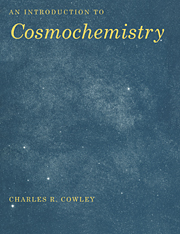Book contents
- Frontmatter
- Contents
- Foreword
- 1 Overview
- 2 Minerals: An Introduction to the Nomenclature and Chemistry
- 3 A Brief Introduction to Petrology
- 4 A Résumé of Thermodynamics and Statistical Mechanics
- 5 Condensation Sequences and the Geochemical Classification of the Elements
- 6 The Theory of the Bulk Composition of the Planets
- 7 Meteorites and the Standard Abundance Distribution (SAD)
- 8 An Introduction to Isotope Geology with an Emphasis on Meteorites
- 9 Some Concepts from Nuclear Physics
- 10 Energy Generation in Stars and Nucleosynthesis
- 11 Atomic and Molecular Spectra
- 12 The Analysis of Stellar Spectra
- 13 The Chemistry of Stars and Stellar Systems
- 14 Cold, Non-stellar Material in Galaxies
- 15 Emission-Line Regions and their Chemical Abundances
- 16 Abundances of the Elements in Galaxies
- Appendix
- References
- Index
16 - Abundances of the Elements in Galaxies
Published online by Cambridge University Press: 05 June 2012
- Frontmatter
- Contents
- Foreword
- 1 Overview
- 2 Minerals: An Introduction to the Nomenclature and Chemistry
- 3 A Brief Introduction to Petrology
- 4 A Résumé of Thermodynamics and Statistical Mechanics
- 5 Condensation Sequences and the Geochemical Classification of the Elements
- 6 The Theory of the Bulk Composition of the Planets
- 7 Meteorites and the Standard Abundance Distribution (SAD)
- 8 An Introduction to Isotope Geology with an Emphasis on Meteorites
- 9 Some Concepts from Nuclear Physics
- 10 Energy Generation in Stars and Nucleosynthesis
- 11 Atomic and Molecular Spectra
- 12 The Analysis of Stellar Spectra
- 13 The Chemistry of Stars and Stellar Systems
- 14 Cold, Non-stellar Material in Galaxies
- 15 Emission-Line Regions and their Chemical Abundances
- 16 Abundances of the Elements in Galaxies
- Appendix
- References
- Index
Summary
An Introduction to Galactic and Extragalactic Research
In the first half of the twentieth century it became clear that our own stellar system was but one of a very large number of galaxies. To be sure, philosophers such as Immanuel Kant had speculated upon the notion of “island universes,” but it was really the work of Edwin Hubble in the mid 1920's that established the great distance of the Andromeda Nebula (galaxy), and clarified the nature of the extragalactic domain as we know it today. His marvelous book The Realm of the Nebulae (Hubble 1936) is now primarily of historical interest.
Hubble made use of certain highly luminous variable stars known as Cepheids. The Harvard astronomer Henrietta Leavitt had shown that the intrinsic brightnesses of these stars could be obtained from their periods of variation. With this relationship in hand, it was only necessary for Hubble to locate such stars in the Andromeda galaxy, and measure their periods and apparent brightnesses. Their distances followed immediately.
An interesting historical sidelight concerns the errors in the calibration of the absolute brightnesses of the Cepheid variables. By a curious combination of errors, Hubble underestimated the distance to the Andromeda galaxy by a factor between two and three. Harlo Shapley, using similar methods to determine the size of our own system, obtained results that were much more nearly correct because of a cancellation of effects of which he was unaware.
- Type
- Chapter
- Information
- An Introduction to Cosmochemistry , pp. 387 - 417Publisher: Cambridge University PressPrint publication year: 1995



